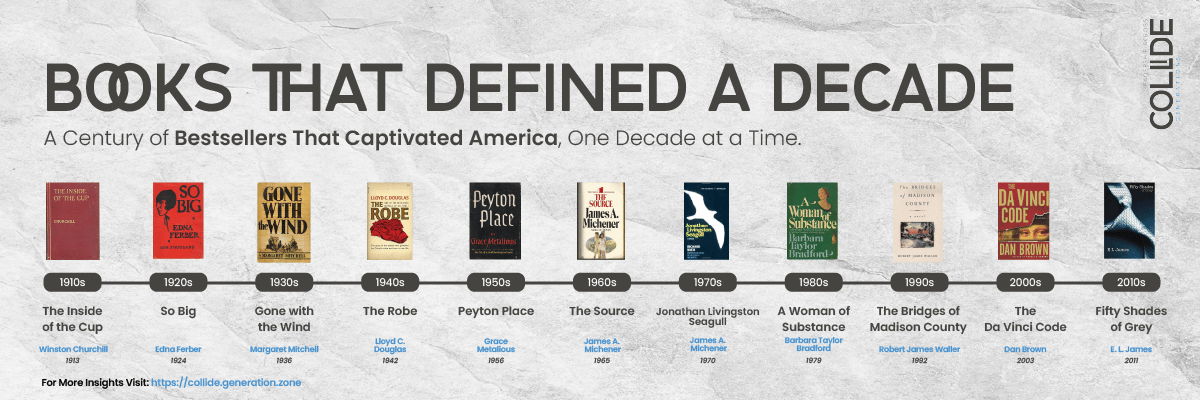- Collide - Generational Leadership
- Posts
- Did Gen Z Inspire Barnes & Noble to open 60 New Locations?
Did Gen Z Inspire Barnes & Noble to open 60 New Locations?
Gen Z Isn’t Addicted to Tech—They’re Starving for Connection

“Reading is so sexy.” That’s the phrase one Gen Zer told The Guardian when asked about their growing preference for physical books over screens. And they’re not alone.
Despite the headlines, stereotypes, and sarcastic memes about Gen Z living on TikTok, something surprising is happening: Barnes & Noble is opening more than 60 new stores across the U.S.—a move that would have seemed unthinkable a decade ago, when the brand was closing locations and fighting for its life (USA Today, 2025).
In an era where everything is digital and dopamine is just a scroll away, why are the youngest generation choosing to spend hours in bookstores, flipping through pages made of pulp?
Because they’re craving what many of us have taken for granted: real life.
Gen Z Grew Up Plugged In—but That’s Not the Whole Story
Born between roughly 1997 and 2012, Gen Z is the first generation that never knew life without wireless internet. The first Wi-Fi standard debuted in 1997—the same year Gen Z began arriving. By the time they could walk, cameras were embedded in cell phones. By middle school, their backpacks were heavier with Chromebooks than with textbooks. And by the time they hit high school, COVID-19 shut down the world and shoved everyone behind a screen.
So, yes—Gen Z is tech-native. But to say they’re obsessed with technology misses the point entirely. They don’t worship technology—they simply exist in it. It’s their atmosphere, not their addiction. Just like previous generations didn’t “love” cars—they just grew up in a world where travel without one was nearly unthinkable.
But something else happened in that digital world: they experienced a different kind of poverty. Not economic, but relational.
Quarantine and remote learning robbed Gen Z of pivotal, formative experiences. High school graduations took place in cars. Freshman year orientations were streamed on Zoom. Even promposals were replaced by DMs. The result? A longing not just for presence, but presence with purpose.
The Bookstore as Rebellion
According to McKinsey, more than 300 new independent bookstores have opened so far in the early 2020s, helping drive an increase of nearly 20 million books sold—with Gen Z leading the charge (McKinsey & Company, 2022). And I’m talking about real books. The ones you can hold in your hands and turn the pages and even get a paper cut. This boom isn’t just about books. It’s about identity, ritual, and resistance.
BookTok, a TikTok trend where users post about books they’re reading, has racked up over 54 million tagged posts as of today (TikTok, 2025). And the most viral videos? Not e-books. Not audiobooks. But thick, tangible, hold-it-in-your-hand paper books.
This isn’t accidental. It’s nostalgic by design. Gen Z is anchoring themselves to analog experiences as a form of stability. In a world of infinite feeds, paper has edges. A bookstore has a smell. A hardcover has weight. These aren’t just preferences, they’re clues to what this generation truly values: depth, embodiment, and intimacy.
What’s more, I just received a Barnes & Noble gift card, from a group I spoke to, comprised of mostly Gen Zers. And I was ecstatic! It brought me back to 1999 book store trips with my dad.
From Isolation to Incarnation
In some ways, Gen Z is experiencing the same pendulum swing we saw in previous generations. Think back to the 1960s and ’70s when the children of post-war industrialization fled cities to join communes and grow their own food. Of course, the whole generation did not flee modernity, but the few that did left for a reason. They weren’t rejecting electricity. They were seeking something that felt more real to them.
Likewise, Gen Z isn’t rejecting tech. They’re rejecting isolation disguised as innovation. They’re not anti-AI or anti-algorithm. Instead, they just want something human to anchor to.
Leadership takeaway? Stop designing experiences for the Gen Z you think you know, the ones glued to their phones. Instead, build for the ones craving eye contact, deep conversations, and real, tactile moments. Now, they might not always look you in the eye or know how to carry on a face-to-face conversaiton, but they are longing for something real.
This generation doesn’t want more virtual. They want meaningful physical. And if we miss that, we’re not just misreading Gen Z. We’re misreading the future.
Then & Now
Gen Z isn’t craving more screen time, they’re craving someone who sees them beyond it. Lead with authenticity. Lead with presence. Invite them out from behind the glass, not by demanding attention—but by offering intention.
Generation Stories…In The Wild
Check out recent articles and posts exploring Gen Z’s propensity to read!

Works Cited
McKinsey & Company. (2022). True Gen: Generation Z and its implications for companies. Retrieved from https://www.mckinsey.com/~/media/mckinsey/email/genz/2022/11/29/2022-11-29b.html
Smith, A. E. (2024, August 21). What Generation Z is really like, according to students. Forbes. Retrieved from https://www.forbes.com/sites/annaesakismith/2024/08/21/what-generation-z-is-really-like-according-to-students/
USA Today. (2025, April 15). Barnes & Noble is opening more stores, again. Retrieved from https://www.usatoday.com/story/money/2025/04/15/barnes-and-noble-opening-new-locations/83102595007/
The Guardian. (2024, February 9). ‘Reading is so sexy’: Gen Z turns to physical books and libraries. Retrieved from https://www.theguardian.com/books/2024/feb/09/reading-is-so-sexy-gen-z-turns-to-physical-books-and-libraries
TikTok. (2025). #BookTok. Retrieved from https://www.tiktok.com/tag/BookTok




Reply